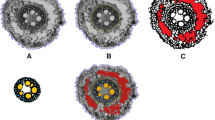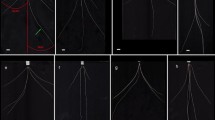Summary
Wheat root characters which influence vital plant processes have scarcely been explored for their genetic control. This study was conducted to i) examine the diversity of root traits and associated shoot traits in spring wheat (Triticum aestivum L.) cultivars; ii) study the nature of genetic control of selected traits; and iii) examine associations among root and shoot traits. Three experiments were conducted in the greenhouse with plants grown in the vermiculite medium in clear plastic tubes. In the first experiment, 42 spring wheat cultivars were grown for three weeks and measurements were taken on root length, leaf length, root number, leaf number, root dry weight, and top dry weight. In the second study, 15F1's originating from a partial diallel mating of six cultivars along with the parents were evaluated for 4 weeks. The data on root length, leaf length, and root number were subjected to diallel analysis according to Griffing's method 4, fixed model. A third experiment consisted of studying 2 F2 populations with 141 plants per population. In the first study the 42 cultivars exhibited a wide range of variation for all six traits. Diallel analysis revealed significant effects of both general combining ability (GCA) and specific combining ability (SCA) for root length, leaf length, and root number. Parents with high GCA estimates were identified. Significant positive correlation coefficients were found among root and shoot traits. Analysis of F2's for root length indicated quantitative nature of inheritance of root length.
Similar content being viewed by others
References
Barber, S.A., 1979. Growth requirements for nutrients in relation to demand at the root surface. In: J.L., Harley & R.S., Russell (Eds). The soil-root interface. Academic Press. New York.
Burton, G.W., 1959. Crop management for improved water-use efficiency. Adv. Agron. 11: 104–108.
Derera, N.F., D.R., Marshall & L.N., Balaam, 1969. Genetic variability in root development in relation to drought tolerance in spring wheats. Expl. Agric. 5: 327–337.
Doodson, J.K., J.G., Manners & A., Myers, 1964. Some effects of yellow rust (Puccinia striiformis) on the growth and yield of a spring wheat. Ann. Bot. 28: 459–472.
Drew, M.C., 1979. Properties of root which influence rates of absorption. In: J.L., Harley & R.S., Russell (Eds). Soil root interface. Academic Press, New York.
Gough, F.J. & O.G., Merkle, 1977. The effect of speckled leaf blotch on root and shoot development of wheat. Plant Dis. Rep. 61: 597–599.
Griffing, B., 1956. Concept of general and specific combining ability in relation to diallel crossing systems. Aust. J. Biol. Sci. 9: 463–493.
Hamilton, D.G., 1941. Certain oat culm characters and their relationship to lodging. Sci. Agric. 21: 646.
Kuspira, J. & J., Unrau, 1957. Genetic analysis of certain characters in common wheat using whole chromosome substitution lines. Can. J. Plant Sci. 37: 300–326.
Lafever, H.N. & L.G., Campbell, 1978. Inheritance of aluminum tolerance in wheat. Can. J. Genet. Cyto. 20: 355–364.
Mac Key, J., 1983. The wheat root. p. 827–842. In: Proc. 4th Int. Wheat Genet. Symp., Missouri Agric. Exp. Stn., Columbia, MO.
Mac Key, J., 1979. Wheat domestication as a root: shoot inter relation process. Proc. 5th Intl. Wheat Genet. Symp., Indian Soc. Genet. and Plant Breeding.
Merkle, O.G., M.A., Famous & E.L., Smith, 1983. Root and shoot variability among 49 wheat genotypes. Agron. Abstr. American Socieity of Agronomy, Madison, WI, p. 73.
Mesdag, J. & L.A.J., Slootmaker, 1969. Classifying wheat varieties for tolerance to high soil acidity. Euphytica 18: 36–42.
O'Brien, L., 1978. Effect of root media on growth of wheat seminal roots. Crop. Sci. 18: 685–687.
Richards, R.A. & J.B., Passioura, 1981a. Seminal root morphology and water use of wheat. I. Environmental effects. Crop Sci. 21: 249–252.
Richards, R.A. & J.B., Passioura, 1981b. Seminal root morphology and water use of wheat. II. Genetic variation. Crop Sci. 21: 253–255.
Sathyanarayanaiah, K. & T.F., Townley-Smith, 1981. Optimum time to screen for wheat (Triticum durum) root development. Can. J. Plant Sci. 61: 492.
Steinberg, R.A., 1953. Symptoms of molybdenum deficiency in tobacco. Plant Physiol. 28: 319–322.
Thimmegowda, S., A., Bommegowda & K., Krishnamurthy, 1974. Note on differences in the production of crown roots and tillers and their relation to yield in wheat genotypes. Indian J. Agric. Sci. 44: 624–626.
Trought, M.C.T. & M.C., Drew, 1980. The development of waterlogging damage in wheat seedlings (Triticum aestivum L.). I. Shoot and root growth in relation to changes in the concentrations of dissolved gases and solutes in the soil solution. Plant and Soil 54: 77–94.
Author information
Authors and Affiliations
Rights and permissions
About this article
Cite this article
Sharma, R.C., Lafever, H.N. Variation for root traits and their genetic control in spring wheat. Euphytica 59, 1–8 (1991). https://doi.org/10.1007/BF00025355
Received:
Accepted:
Issue Date:
DOI: https://doi.org/10.1007/BF00025355




